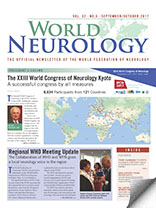By Professor Gian Domenico Borasio, Lausanne, Switzerland
and Professor David Oliver, Canterbury, U.K.
Modern palliative care traces its origins to the pioneering work of Dame Cicely Saunders who founded the first modern hospice, St. Christopher’s Hospice, in 1967 in London. Although most patients in St. Christopher’s suffered from cancer (as indeed most patients followed by palliative care teams to this day), a small group of patients did not. From the beginning, a few beds were reserved for patients with amyotrophic lateral sclerosis (ALS).
ALS has since become a paradigm disease for non-oncological palliative care, and it was the first non-cancer disease to have a textbook devoted to its palliative care to be published (albeit as late as in 2000).1 In 2016, a consensus document on palliative care and neurology was produced by the European Academy of Neurology and the European Association for Palliative Care.2
The World Health Organization (WHO) definition of palliative care states that “palliative care is an approach which improves quality of life of patients and their families facing life-threatening illness.”3 There can be little doubt that a large proportion of neurological patients fall into this category.4 Indeed, given the progressive clinical course and the lack of curative options for most neurodegenerative disorders, one would assume that neurological patients and their families would stand to benefit greatly from an integration of the palliative approach into neurological practice.
Palliative Care on the Program
For the first time in the history of the World Congress of Neurology, two sessions on palliative care were held as part of the scientific program in Kyoto. The sessions were organized by Professor Wolfgang Grisold, secretary general of the WFN, and Professor Gian Domenico Borasio, neurologist and chair in palliative medicine at the University of Lausanne in Switzerland.
The first session, which covered the general concepts of palliative care, opened with a remarkable talk by Dr. Rajagopal from Kerala, India. Dr. Rajagopal has created an impressive palliative care network in an extremely resource-poor environment. He poignantly reminded us that palliative care in developing countries must respond to other problems than in industrialized ones, but that it is no less important. Following up on this, Professor Ogino, of Narita, Japan, described the challenges of palliative care from a transcultural perspective. There are large differences between Asian and European countries in the percentage of people dying at home, the opioid administration at the end of life, and the legal regulations for the end of life. However, a common feature across many countries is the fact that palliative care is mostly, if not exclusively, available for cancer patients, while access to palliative care for neurological patients remains challenging. Prof. Borasio approached the sensitive topic of end-of-life decisions in neurology, focusing on the crucial role of medical indication and the need for good communication skills on the neurologists’ side.5
In the second session, which was devoted to clinical examples of neurological palliative care, Professor Monika Führer, of Munich, Germany, showed impressive data on neurological involvement in pediatric palliative care, which turns out to be present and significant in 75 percent of patients.6 Cancer accounts for only about 20 percent of pediatric palliative care patients, further underscoring the importance of neurological palliative care in this context.
Prof. Grisold provided a description of the needs and problems faced by patients with advanced neuro-oncological disorders, which are compounded by the progressive loss in decision-making capacity and the emergence of behavioral disturbances.7 Professor David Oliver, who also is a board member of the European Association for Palliative Care, described in detail the manifold possibilities that palliative care offers to improve the quality of life of patients with ALS and their families. Often enough, these measures also have a demonstrable positive effect on patient survival as well.8
The sessions were well attended, and the discussants highlighted their own experiences from places as diverse as Australia, Europe, Japan, and Sri Lanka. Common themes were the difficulty to provide adequate palliative care to neurological patients, the lack of evidence-based guidelines, and the challenge of colleagues confusing palliative care with terminal care.
We sincerely hope that future WCN meetings will continue to offer attendees the possibility to hear about the most recent developments for this crucial topic for clinical neurological practice.
References
- Oliver D, Borasio GD, Johnston W.(eds) Palliative care in amyotrophic lateral sclerosis: form diagnosis to bereavement. 3rd edition. 2014. Oxford. Oxford University Press.
- Oliver DJ, Borasio GD, Caraceni A, de Visser M, Grisold W, Lorenzl S, Veronese S, Voltz R. A consensus review on the development of palliative care for patients with chronic and progressive neurological disease. Eur J Neurol 2016;23:30-38.
- Sepulveda C, Marlin A, Yoshida T, Ullrich A. Palliative Care: The World Health’s Organization global perspective. J Pain Symptom Manage 2002;24:91-96
- Borasio GD. The role of palliative care for patients with neurological diseases. Nat Rev Neurol 2013;9:292-295
- Borasio GD, Jox R. Choosing wisely at the end of life: the crucial role of medical indication. Swiss Med Wkly 2016:146:w14369
- Bender HU, Riester MB, Borasio GD, Führer M. “Let’s bring her home first.” Patient characteristics and place of death in specialized pediatric palliative home care. J Pain Symptom Manage 2017;54:159-166
- Pace A, Dirven L, Koekkoek JAF, et al. European Association for Neuro-Oncology (EANO) guidelines for palliative care in adults with glioma. Lancet Oncol 2017;18(6):e330-e340
- Mitchell D, Borasio GD. Amyotrophic lateral sclerosis/motor neurone disease. Lancet 2007;369:2031-2041
